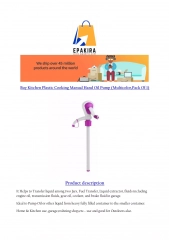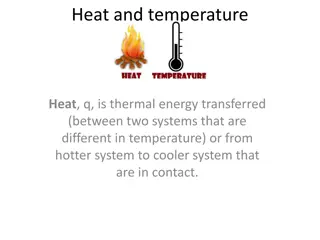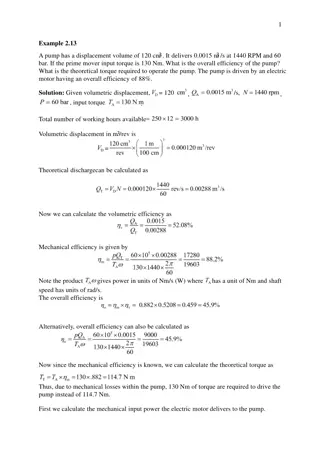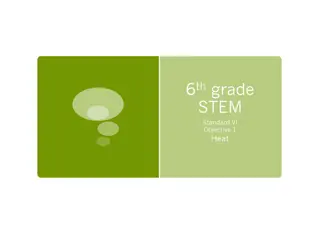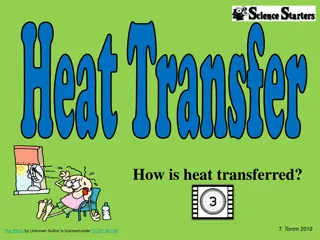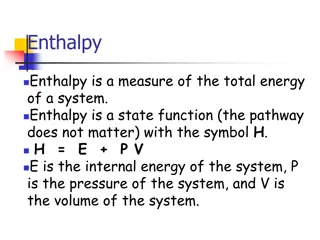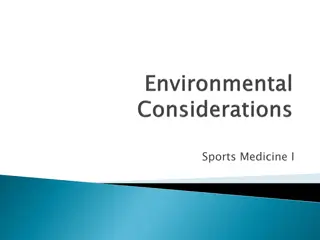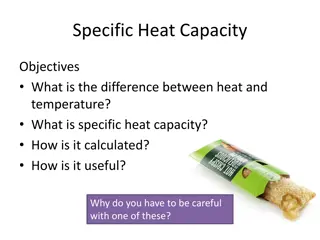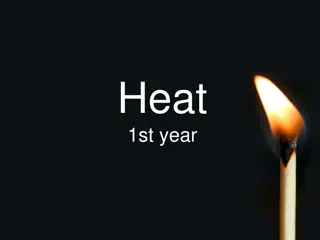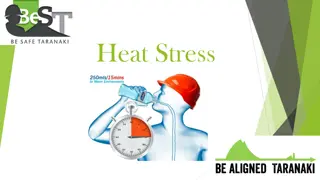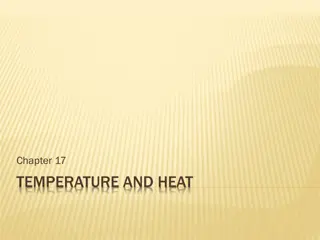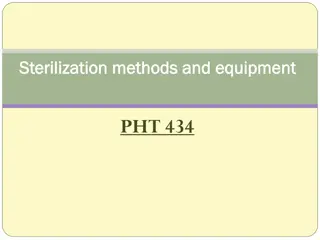Energy Efficiency and Innovation in Heat Pump Technology
Explore the latest advancements in heat pump technology, including monovalent and bivalent systems, RHI regulations, efficient layouts for ASHP and GSHP, factors impacting efficiency, and best practices for installation and maintenance to ensure optimal performance and sustainability.
Download Presentation

Please find below an Image/Link to download the presentation.
The content on the website is provided AS IS for your information and personal use only. It may not be sold, licensed, or shared on other websites without obtaining consent from the author.If you encounter any issues during the download, it is possible that the publisher has removed the file from their server.
You are allowed to download the files provided on this website for personal or commercial use, subject to the condition that they are used lawfully. All files are the property of their respective owners.
The content on the website is provided AS IS for your information and personal use only. It may not be sold, licensed, or shared on other websites without obtaining consent from the author.
E N D
Presentation Transcript
Heat pump revision ASHP A7W35 A=air GSHP B0W35 B=brine Low pressure 7bar High pressure 22-26bar Monovalent=heat pump only heat source Bivalent=dual system heat pump and perhaps another source
RHI e-mail is sent every twelve months to confirm, installation is unchanged No TRVS are good for circulation Placing damp proof course under ASHP will prevent foundation damaged Solar deemed RHI only Above 50c RHI payment is almost zero Oil hybrids require buffers of 20 litres per 1 kw Fan coil sprays 45c to avoid nuisance Refractometer measures light reflection Blue coat has teflon in for durability Defrost can cause steaming
Heat pump revision ASHP has blue coat technology to prevent ice forming and corrosion GSHP Glycol-Propelene is used non toxic ASHP Glycol-Ethelene tonic to plants/pets Pipe work is a W plan heating priority should system fail hot water is shut off
Heat pump revision GSHP lay out Remove stones Wet ground and damp areas are best for heat source GSHP lay out must be 0.8m apart Slinky method is not recommended i.e 10kw GSHP 2.5kw = 7.5kw 7.5kw x 1000 = 7500 7500 24 = 300m2 area (24 is ground heat source for a damp soil) 300m2 0.8 = pipe needed
Heat pump revision Efficiency determined by dividing Heat pump output Electrical input/usage SPF seasonal performance factor Heat pump energy used over year Factors Peak load Controls Demand
Heat pump revision 6 average UK outside temperature Inverter compressor more efficient then buffer not required Buffers reduce compressor cycling ASHP average 20-25ltre per/Kw
Heat pump revision Kw output 7500 =300m Specific heat extraction for soil 25 Vaillant ground source have Primary hot water circulate for cylinders Brine is used for GSHP due to Glycol being toxic Brine Ethylene salt water Sight glasses to view condition of anti-freeze and refrigerate
Heat pump revision Collector difference should be 3 Horizontal collectors must be 0.8m apart Not permitted where wind turbines are installed Collectors must be 1m away from foundation 4 way valve operates reverse flow to defrost heat pump Heat pumps are 5% VAt
Heat pump revision GSHP collectors must HDPE Estimate GSHP requires twice house floor area GSHP 55 ASHP 35 Heat pumps are not allowed near bedrooms
Heat pump revision Commissioning Flush / test / Sample water Clearances / Manufacturers instructions / Electrical Inspect components / clean / fluid levels
Heat pump revision GSHP Purge air / remove debris / check flow rate / discharge correct container Add anti freeze GSHP can have open loops from lakes
Heat pump revision Monovalent single heat pump Bivalent heat pump with SH (supplementary heating) GSHP avoid Dry ground Stones Slinky method
ODP Ozone depletion potential GDP global depletion potential Boreholes must more than 15m apart W plan system must be installed Y so failure will close priority to hot water
Heat pump typical temperatures and pressures 7 C 75 C Bicycle pump 7.3 bar 22 bar High pressure high temperature gas Low pressure gas Steam Heating flow 35 C Plate heat exchanger Compressor Heat from ambient air Window Condensation External heat Compressor exchanger 7 C 2 C 30 C Heating return Expansion device Boiling Liquid/vapour High pressure liquid Aerosol can 33 C 1 C 21.5 bar 7.5 bar
Typical Air to Water Heat Pump components Air to refrigerant Heat exchanger (Evaporator coil) Reversing valve Accumulator Electronics box Fan motor & blade 9 Circulation pump Refrigerant to water Plate heat exchanger Compressor Flow sensor Expansion device
Rule of thumb heatloss method (Not MCS) Not a designed heatloss, but useful to decide whether heatpumps are right for the project. UPVC/wood Double glazing, + loft & cavity wall insulation No improvement to insulation UPVC/wood Double glazing, + loft insulation 1970 to 1995 100 W/m2 85 W/m2 70 W/m2 1996 to 2005 80 W/m2 70 W/m2 60 W/m2 2006 to 2010 50 W/m2 50 W/m2 50 W/m2 New build 40 W/m2 40 W/m2 40 W/m2
W Plan valve arrangement A B Vollbild anzeigen A B Honeywell 4044C W plan valve or equivalent W plan valve connected in central heating priority, wired in DHW priority to satisfy G3
Reducing Noise Impact Measures to reduce noise impact Consider carefully the position of the unit do not place near windows or doors Always ensure the heat pump is fitted to a solid base and use the supplied anti-vibration mounts under the unit Surround heat pump with plants to deaden noise always ensuring minimum clearances are met.
geoTHERM air - Condensate The geoTHERM air heat pump will produce condensate as part of it s normal operation The external coil will frost up particularly in low ambient conditions The heat pump operates in reverse cycle to automatically defrost The water produced collects in the bottom tray and is discharged via the drain hose adaptor The adaptor can be fitted in either end of the heat pump to match the fall of the unit The supplied blank is fitted into the other outlet This condensate should not be confused with the acidic condensate produced by high efficiency boilers
Connecting heat pump to the system Flexible hoses must be used to connect heat pump to system Full bore isolation valves to allow heat pump disconnection from system Any external pipework must be insulated with UV resistant and peck proof insulation Consideration should be taken into account when entering the property, entrance hole should be resealed to prevent heat loss A filter must be fitted on the return internal to the property.
Horizontal depth 0.8-2m Lakes are the best heat source DX rare in UK-direct expansion uses refrigerant not glycol in loop Natural gas is not RHI applicable PDR-planning development rights
Planning permission issues Wind turbine fitted Conservation area (may be visible) Heat pump housing must be less than 0.6m2 Installing on wall, highway front and 1m of boundary
Heat pumps are designed at 55db But assessment should be 42db Boreholes are 180mm wide 85% of renewable are incorrectly installed GSHP 55-65 Heat pumps are maintenance free just glycol test
Meter installed for RHI and insulation but no financial gain on hybrids R410a refrigerant, the higher the number higher the ODP is Low pressure 7bar high pressure 22bar GSHP scroll ASHP inverter
ODP ozone depletion potential R22 banned R10 healthier Scroll traps gas in between metal coil Dry receiver collects moisture from refrigerant prior to the compressor
4 way reverse valve activates for 90secs to 21minutes EN 14511 European test standard Data badge states refrigerant and COP SPF must be at least 2.5 for RHI
Correction factor formula Flow + return temperature 2= 55 45= 50 Mean temperature desired room temp = 50 21= 29 30 correction factor 0.5148
Standard design temperature Underfloor 35 Fan assisted 45 Standard Radiator 55 Watts= correction factor m
15kw Heat pump has two fan coils Second Heat pump requires planning permission Balance Point where system heat source changes from AWHP to gas FLEQ full load equivalent hours
Temperature difference Time to heat hot water 135litre x 50 = 76.5 minutes 60 4.186 Design hot water temperature Specific heat capacity of water
Kw required to heat DHW 135litre x 50 x 4.186 = 78.5Kw 3600 Daily demand 3 + 1 x 45 litres = daily demand Number of rooms
Underfloor heating 35 Fan assisted 45 Convectional radiators 55 AWHP valid positioning allowed in rooms of size to handle F-gas leakage Refrigerate charge Practical limit (kg/m3) = 2.2 =5m3 0.44
Buffer vessel sizing Kw of appliance Time between Heat pump start and stopping 60 seconds 5 x 15 x 60 = 4500 = 215 litres 4.18 x 5 20.935 Temperature difference between flow and return Joules 215 100 = 115 litres System content volume
ODP- ozone depletion potential Electrical 16amp type B Noise reduction reduces Kw by 0.5Kw VWL L means Luft which is air Blank cap blows off under frost expansion 30 watts warms up oil around compressor for an hour
Thawing begins at 3 for 3 10 mins Plate to plate can be used for 18Kw High pressure sensor switches off at 41.5bar Schematic settings for 470 1 5 boiler 6 7 heat pump 8 12 hybrid Always switch on accessories prior to 470
Maximum temperature is 63 Lowest temperature -15 Ground loop diameter guidelines 28mm = 100metres 32mm = 200metres 40mm = 400 metres
1m at 8degrees 2m at 12degrees 42db at assessment point ASHP electrics are designed to be water tight Casing screws are anti seize material
DNO form A required for 20amp single phrase supply HEAT METERS must be installed by persons qualified 1.5m between water mains and ground collector
15Kw heat pump, requires planning permission as the cubic area is greater than 0.6m3 Night feature on 15Kw looses 2Kw Partially parallel bivalent measures both in buffer 8 miles within coast, remove blue coat, then apply Blygold creates durability and more efficiency
Energy metering Meter has two valves ready for installation which is installed on return and flow temperature on flow..........any additional supplementary heating must be metered Good for heated return and defrost inefficient as the return is too hot by avoiding buffer
40mm only for collector diameter = 1 litre per/meter, 2 parts per 1 glycol sea open water needs titanium components with have an abstract licence ground flows can round together water flow rate must be measured GSHP system program purge is 50min
Degree minutes from buffer VF1, weather compensator and heat curve Actual temp Gives target temperature- calculated temp DM= calculated flow actual flow 0 0=demand off -120 Hp begins -600 supplementary heater but doesn't work till 720 switches off at 480 Positive warmer then target Negative colder then target Monitor Dm for direction of target and actual for demand



